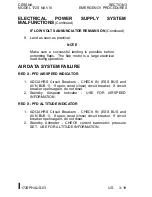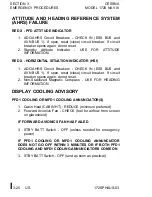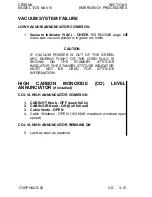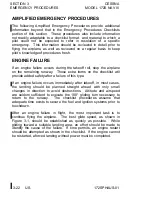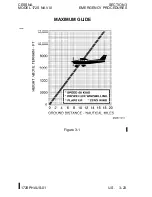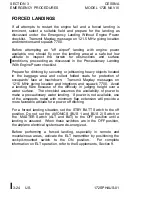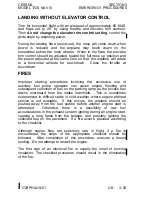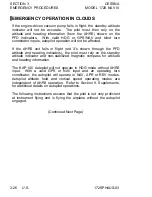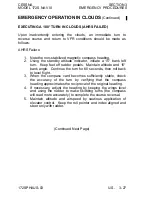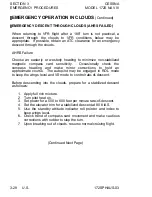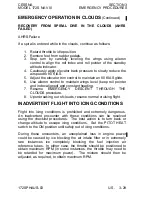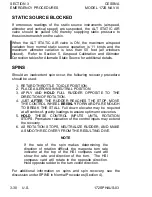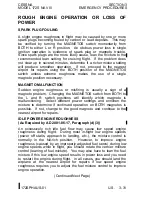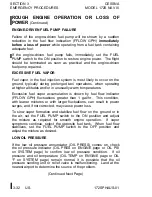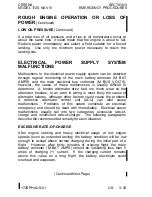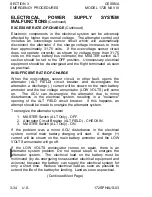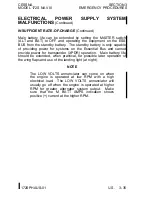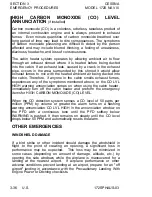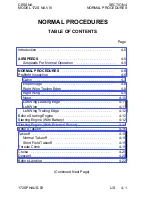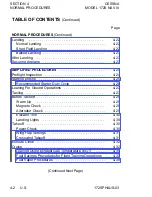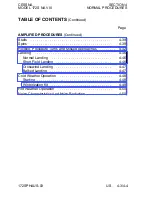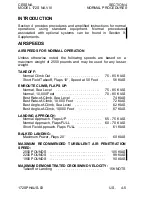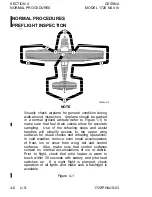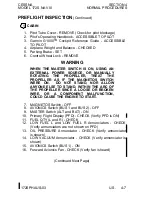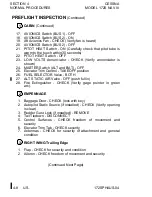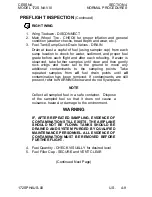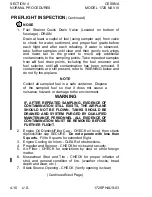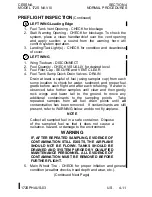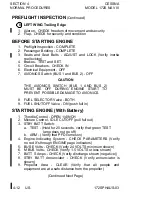
CESSNA
SECTION 3
MODEL 172S NAV III
EMERGENCY PROCEDURES
ROUGH ENGINE OPERATION OR LOSS OF
POWER
(Continued)
LOW OIL PRESSURE (Continued)
If a total loss of oil pressure and a rise in oil temperature occur at
about the same time, it could mean that the engine is about to fail.
Reduce power immediately and select a field suitable for a forced
landing. Use only the minimum power necessary to reach the
landing site.
ELECTRICAL POWER SUPPLY SYSTEM
MALFUNCTIONS
Malfunctions in the electrical power supply system can be detected
through regular monitoring of the main battery ammeter (M BAT
AMPS) and the main electrical bus voltmeter (M BUS VOLTS);
however, the cause of these malfunctions is usually difficult to
determine. A broken alternator drive belt, too much wear on the
alternator brushes, or an error in wiring is most likely the cause of
alternator failures, although other factors could cause the problem.
A defective alternator control unit (ACU) can also cause
malfunctions. Problems of this nature constitute an electrical
emergency and should be dealt with immediately. Electrical power
malfunctions usually fall into two categories: excessive rate-of-
charge and insufficient rate-of-charge. The following paragraphs
describe the recommended remedy for each situation.
EXCESSIVE RATE-OF-CHARGE
After engine starting and heavy electrical usage at low engine
speeds (such as extended taxiing) the battery condition will be low
enough to accept above normal charging during the initial part of a
flight. However, after thirty minutes of cruising flight, the main
battery ammeter (M BAT AMPS) should be indicating less than 5
amps of charging (+) current. If the charging current remains
above this value on a long flight, the battery electrolyte could
overheat and evaporate.
(Continued Next Page)
I
172SPHAUS-01
U.S. 3-33
Содержание 172S Skyhawk SP NAV III 2005
Страница 4: ......
Страница 6: ......
Страница 8: ......
Страница 10: ......
Страница 24: ...SECTION 1 CESSNA GENERAL MODEL 172S NAV III Figure 1 2 Weight Conversions Sheet 2 1 16 U S 172SPHAUS 00 ...
Страница 26: ...SECTION 1 CESSNA GENERAL MODEL 172S NAV III Figure 1 3 Length Conversions Sheet 2 1 18 U S 172SPHAUS 00 ...
Страница 28: ...SECTION 1 CESSNA GENERAL MODEL 172S NAV III Figure 1 4 Length Conversions Sheet 2 1 20 U S 172SPHAUS 00 ...
Страница 29: ...CESSNA SECTION 1 MODEL 172S NAV III GENERAL Figure 1 5 Distance Conversions 172SPHAUS 00 U S 1 21 ...
Страница 31: ...CESSNA SECTION 1 MODEL 172S NAV III GENERAL Figure 1 6 Volume Conversions Sheet 2 172SPHAUS 00 U S 1 23 ...
Страница 32: ...SECTION 1 CESSNA GENERAL MODEL 172S NAV III Figure 1 6 Volume Conversions Sheet 3 1 24 U S 172SPHAUS 00 ...
Страница 33: ...CESSNA SECTION 1 MODEL 172S NAV III GENERAL Figure 1 7 Temperature Conversions 172SPHAUS 00 U S 1 25 ...
Страница 35: ...CESSNA SECTION 1 MODEL 172S NAV III GENERAL Figure 1 9 Volume to Weight Conversion 172SPHAUS 00 U S 1 27 ...
Страница 36: ...SECTION 1 CESSNA GENERAL MODEL 172S NAV III Figure 1 10 Quick Conversions 1 28 U S 172SPHAUS 00 ...
Страница 38: ......
Страница 60: ......
Страница 64: ......
Страница 83: ...CESSNA SECTION 3 MODEL 172S NAV III EMERGENCY PROCEDURES MAXIMUM GLIDE Figure 3 1 I172SPHAUS 01 U S 3 23 ...
Страница 100: ......
Страница 148: ......
Страница 157: ...CESSNA SECTION 5 MODEL 172S NAV III PERFORMANCE Figure 5 2 Temperature Conversion Chart 172SPHAUS 00 U S 5 11 ...
Страница 170: ......
Страница 172: ......
Страница 194: ......
Страница 198: ......
Страница 294: ......
Страница 296: ......
Страница 320: ...SECTION 9 SUPPLEMENTS CESSNA SUPPLEMENT 3 MODEL 172S NAV III Figure S3 1 FAA APPROVED S3 8 U S 172SPHAUS S3 00 ...
Страница 366: ......
Страница 408: ......
Страница 422: ......

